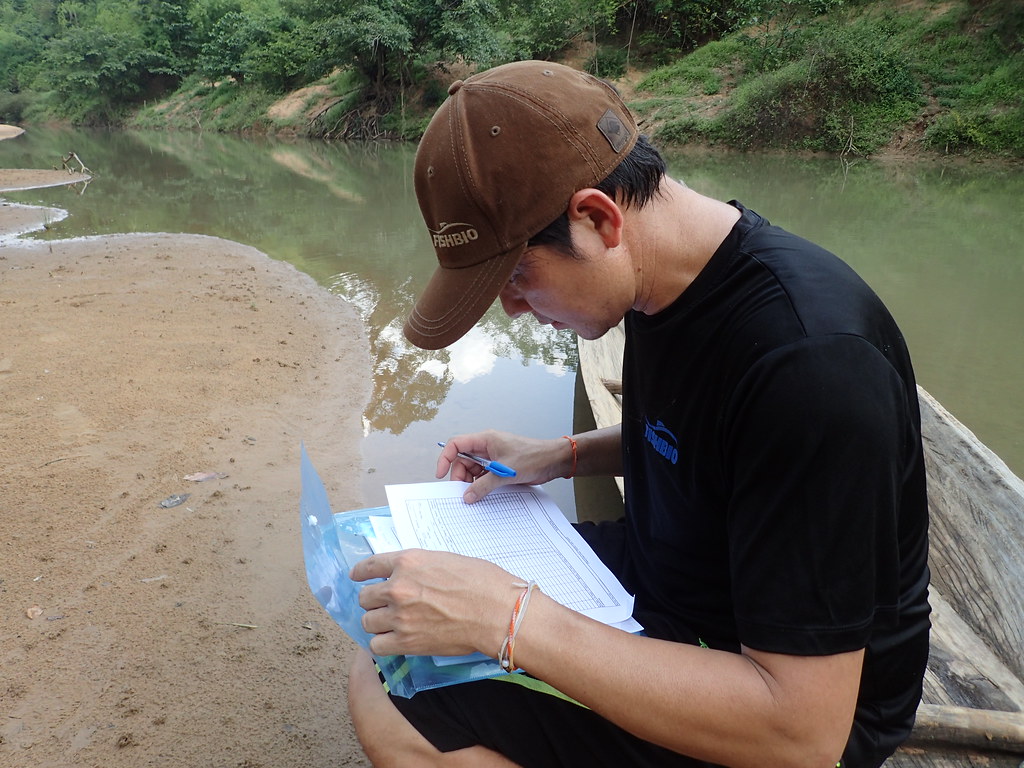Monday February 28, 2022

Protected areas don’t come with an indicator light to signal how well they are performing – instead, their success has to be investigated through monitoring and evaluation. While much effort has gone into developing guidelines for evaluating marine protected areas (MPAs) in the ocean, fewer resources exist for evaluating protected areas in freshwater environments. To help address this gap, FISHBIO staff developed a guidebook for monitoring community-managed freshwater protected areas (FPAs) in Laos. This process included a literature review of different indicators that have been used to measure success in both marine and freshwater protected areas. Our results published in the journal Water discuss these indicators in the context of monitoring community-managed freshwater protected areas in the Lower Mekong Basin (Loury and Ainsley 2020). We found that most of the indicators measured in marine settings can readily be measured in freshwater settings (although sometimes by using different methods), and that environmental aspects of protected areas are much more frequently studied than the human dimensions, which highlights needs to be addressed in future studies.
Indicators typically relate to specific management goals and objectives, and can be measured as a way of evaluating management effectiveness. For example, if the goal of an aquatic protected area is to increase the amount of fish in the area, then the indicator of total fish abundance should be measured to determine whether this goal is being met. Our review drew on three categories of indicators used in a guidebook for evaluating MPAs (How is Your MPA Doing): biophysical, socioeconomic, and governance. Biophysical indicators such as species abundance, habitat complexity, and water quality are used to assess the aquatic environment. Socioeconomic indicators such as fishing patterns, household income distribution, and perceptions of protected area benefits are used to assess impacts on local communities. And governance indicators such as the existence of a management plan, stakeholder participation in management, and compliance with regulations are used to assess aspects of managing a protected area. In 2015, our team conducted a literature review of 155 papers, of which 73 discussed marine protected areas (with a focus on review articles), and 75 discussed freshwater protected areas and freshwater conservation.

Of the freshwater papers reviewed, less than one-third (28%) described or measured indicators in a freshwater protected area, highlighting a dearth of peer-reviewed FPA evaluations. The review also found that biophysical indicators are much more frequently measured than socioeconomic and governance indicators in studies of both MPAs and FPAs. Since aquatic protected areas typically restrict local communities’ access to resources, the human dimensions of a protected area’s performance represent an important topic for further study, and methods used to survey community members and managers about MPAs could readily be transferred to studies of FPAs. In contrast, methods used to measure marine biophysical indicators may not always be suitable for a freshwater context. For example, visual census surveys using snorkel or scuba are frequently used in the ocean, but are less effective in frequently turbid freshwater environments (with Koning et al. 2020 being a notable recent exception). Surveys using nets, traps, and other local fishing gear may be suitable for freshwater surveys, especially in community-managed FPAs. One relevant lesson from the MPA literature is that standardized methods should be considered across FPA assessments to facilitate comparisons between locations or over time.
Community participation is vital in all aspects of implementing a community-managed protected area, including evaluation, and the paper discusses considerations for measuring indicators in the context of community-based management. Many governance indicators are among the more straightforward to measure, and therefore could be a good starting point for communities seeking to conduct evaluations on their own. Creating interdisciplinary evaluation teams with both environmental and social scientists, as well as local community members, can help ensure that a balanced suite of indicators is used in assessments. Evaluations are critical to determine whether the resources invested to set up and manage aquatic protected areas are producing the intended outcomes, or whether adjustments are necessary. The number of studies that evaluate freshwater protected areas is small but growing, and recently developed guidelines can be used to give these protected areas regular “checkups” and ensure that they are running smoothly and effectively.
This post featured in our weekly e-newsletter, the Fish Report. You can subscribe to the Fish Report here.
